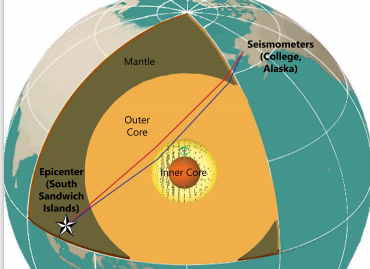Deep inside the Earth's interior, almost to the core, through the crust and mantle. Researchers will utilize seismic waves to illustrate how, like radar waves, they reverberate through the world after an earthquake and expose its fundamental structure.

Zones Near the Core

There are zones near the core where seismic waves slow to a crawl. According to a new study from the University of Utah, these cryptic and descriptively termed ultra-low velocity zones are unexpectedly complex. Modeling implies that some of these zones may be leftovers from the processes that created the early clumps of flour in the bottom of a batter bowl-remnants of inadequate mixing.
"Of all the phenomena we know about in the deep mantle, ultra-low velocity zones are probably the most severe," says Michael S. Thorne, associate professor in the Department of Geology and Geophysics at the University of Texas at Austin. "These are, without a doubt, some of the planet's most severe characteristics."
The work was published by the National Science Foundation and published in Nature Geoscience.
Related Article : How These Oddly Contorted Oceanic Plate Triggered a Complex Earthquake in New Zealand
Studying the Earth's Structure
What is the structure of the Earth's interior? The crust is a small layer of solid rock on which we live. The mantle is the layer of the planet that lies between the crust and the iron-nickel core at its core. It's not an ocean of lava; instead, it's a solid rock that's hot and has the potential to move, which causes plate tectonics near the surface.
How are we supposed to know what's happening in the mantle and core? Waves of the Earth's crust. Scientists on the ground can measure how and when the waves arrive at monitoring stations throughout the world as they ripple through the Earth following an earthquake. Using those observations, they can compute how the waves were reflected and deflected by structures within the Earth, including layers of varying densities. That's partly how we figure out where the borders of the crust, mantle, and core are-and what they're comprised of.
Atop the liquid metal outer core at the bottom of the mantle are ultra-low velocity zones. Seismic waves decelerate by up to half in certain places, while density rises by a third.
Methods
Initially, scientists considered that these zones were locations where the mantle was partially molten and may be the source of magma for "hot spot" volcanic regions like Iceland.
"However, most ultra-low velocity zones don't appear to be located beneath hot spot volcanoes," Thorne explains, "so that can't be the full answer."
So Thorne, postdoctoral scholar Surya Pachhai, and colleagues from the Australian National University, Arizona State University, and the University of Calgary set out to investigate another possibility: that the ultra-low velocity zones are made up of different rocks than the rest of the mantle, and that their composition may date back to the early Earth.
According to Thorne, perhaps ultra-low velocity zones are clumps of iron oxide, which we perceive as rust on the surface but can act as a metal in the deep mantle. If this is the case, pockets of iron oxide just outside the core might impact the Earth's magnetic field, which is formed just below the surface.
Pachhai explains that "the physical properties of ultra-low velocity zones are linked to their origin," which "provides important information about the thermal and chemical status, evolution, and dynamics of Earth's lowermost mantle-an essential part of mantle convection that drives plate tectonics."
The researchers explored ultra-low velocity zones beneath the Coral Sea between Australia and New Zealand to gain a clear image. The profusion of earthquakes in the area gives a high-resolution seismic image of the core-mantle boundary, making it an attractive site. High-resolution measurements were hoped to reveal how ultra-low velocity zones are constructed.
Conclusion

The study offers some evidence for the origins of certain ultra-low velocity zones. Still, there is also evidence that others, such as the melting of ocean crust falling back into the mantle, have distinct beginnings. However, if certain ultra-low velocity zones represent remnants from the early Earth, they retain some of the planet's history that would otherwise be lost.
"As a result of our finding, we now have a tool to comprehend the original temperature and chemical condition of Earth's mantle, as well as their long-term evolution," Pachhai explains.
For more Space news, don't forget to follow Nature World News!
© 2025 NatureWorldNews.com All rights reserved. Do not reproduce without permission.





